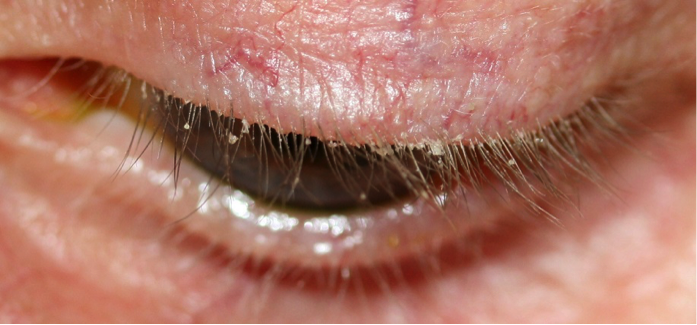 Blepharitis is a common inflammatory condition of the eyelids. This condition is often caused by a build-up of bacteria living along these areas, making the eyelid margins red, swollen and inflamed. Pinpointing the underlying cause of Blepharitis is difficult at times but technology available at PersonalEyes Vision Care allows ones condition to be resolved sooner than traditionally managed. Remember, Blepharitis can be a chronic condition is not is not properly treated.
Blepharitis is a common inflammatory condition of the eyelids. This condition is often caused by a build-up of bacteria living along these areas, making the eyelid margins red, swollen and inflamed. Pinpointing the underlying cause of Blepharitis is difficult at times but technology available at PersonalEyes Vision Care allows ones condition to be resolved sooner than traditionally managed. Remember, Blepharitis can be a chronic condition is not is not properly treated.
Types of Blepharitis
There are two main types: Anterior Blepharitis and Posterior Blepharitis. Anterior Blepharitis is when inflammation affects the skin around the base of the eyelashes. Posterior Blepharitis is when inflammation affects the glands inside the eyelids.
Meibomian Gland Dysfunction (MGD), a type of Posterior Blepharitis, is one of the most commons eyelid conditions diagnosed by an Optometrist. Other types include chalazions or internal/external hordeolums (painful & non-painful stypes). MGD occurs when majority of the eyelids glands become clogged.
Symptoms & Causes of Blepharitis
Symptoms include some or all of the following:
-
- Red, itchy and sore eyelids
- Crusty or greasy eyelashes (stickiness)
- Burning or sandy, gritty sensation in the eyes
- Eyelash dandruff
Below is a list of possible causes of Blepharitis:
-
- Meibomian Gland Dysfunction
- Build up of oil and debris on the eyelids and lashes
- Bacterial eyelid infections
- Complication of skin conditions such as Rosacea or Seborrhoeic Dermatitis
Treatment Options
Daily lid hygiene is the most effective treatment plan for Blepharitis. As stated above, bacteria is common in and around the eyes. Cleaning the base of the eyelashes and eyelid margins morning and night will help reduce reoccurrences of Blepharitis.
“Cleaning eyelashes is just as important as flossing your teeth”
Compliance is key treating various difference conditions, such as Blepharitis, Dry Eye Syndrome, Meibomian Gland Dysfunction, Styes and many more. Most patients’ self discontinue treatment when they visibly see the condition better or gone. That is not enough. Doctors use high powered microscopes on follow-up visits to see if the condition is truly resolved or not. Below is a list of different treatments. Upon your visit with Dr. Patel, a customized treatment plan will be created for your condition.
-
- Heated Eye Mask – Hot compress applied to the top of the eyelids will help soften oils in the glands, allowing for the oils to flow regularly into ones tear film. Just 10 minutes of heat applied twice a day is all it takes
- Massage – Immediately after applying heat, one just take their index finger and roll/massage the eyelids. This help loosen up the oils and direct them out of the glands so more can be produces with efficiency.
- Hygiene – Lid Hygiene is similar to oral hygiene and just as important. There are numerous ways to clean debris, excess bacteria and oils from the surface on a daily basis. The old-fashion way involves baby shampoo and a warm, soft wash cloth. There are newer ways to clean eyelids for a longer-lasting outcome. Properly formulated Tea-Tree Oil Wipes are a gold standard way to keep eyelids clean.
- Artificial Tears – In todays world, there are 100’s of lubricating options available. The reason is because there are numerous types of Dry Eyes, varying from occupational dry eyes to medication related and everything else in between. Consult with Dr. Patel today to see which drops are required for your condition.
- Omega-3 Fish Oils – Optometrists may recommend either a diet rich in Omega-3 fatty acids and/or the use of supplements to help manage Blepharitis. Consuming theses fish oils can improve the oils in your glands. Just like artificial tears, there are 100s of fish oil products out there in the world. Luckily, Dr. Patel loves conducting fish oil quality experiments. These highly absorbable Omega-3’s can be found in our EyeShop.
Start Being Proactive Today!
Immediate Recommendation
- 1. Remove all eye make-up before bedtime. Special lid wipes are available.
- 2. Do not share eye make-up with others.
- 3. Do not share towels or facecloths with others.
- 4. Clean eyelids and eyelashes twice daily with soft wash cloth.
- 5. Call our office immediately if condition continues to worsen
Blepharitis and other related eye issues are considered time-sensitive condition. Click Here to schedule a consultation with Dr. Patel today and feel the relief TODAY!
